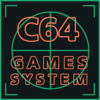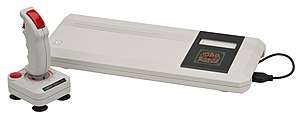Commodore 64 Games System
The Commodore 64 Games System (often abbreviated C64GS) is the cartridge-based home video game console version of the popular Commodore 64 home computer. It was released in December 1990 by Commodore into a booming console market dominated by Nintendo and Sega. It was only released in Europe and was a considerable commercial failure.
 | |
 | |
| Manufacturer | Commodore International |
|---|---|
| Type | Home video game console |
| Generation | Third generation (8-Bit era) |
| Release date | December 1990[1] |
| Media | Cartridge |
| Predecessor | Commodore TV Game |
| Successor | Commodore CDTV |
The C64GS came bundled with a cartridge that featured four games: Fiendish Freddy's Big Top O'Fun, International Soccer, Flimbo's Quest and Klax.
The C64GS was not Commodore's first gaming system based on the C64 hardware. However, unlike the 1982 MAX Machine (a game-oriented computer based on a very cut-down version of the same hardware family), the C64GS is internally very similar to the complete C64, with which it is compatible.
Available software
Support from games companies was limited, as many were unconvinced that the C64GS would be a success in the console market. Ocean Software was the most supportive, offering a wide range of titles, some C64GS cartridge-based only, offering features in games that would have been impossible on cassette-based games, others straight ports of games for the original C64.[2] Domark and System 3 also released a number of titles for the system, and conversions of some Codemasters and MicroProse games also appeared. Denton Designs also released some games, among them Bounces, which was released in 1985.
The software bundled with the C64GS, a four-game cartridge containing Fiendish Freddy's Big Top O'Fun, International Soccer, Flimbo's Quest and Klax, were likely the most well known on the system. These games, with the exception of International Soccer, were previously ordinary tape-based games, but their structure and control systems (no keyboard needed) made them well-suited to the new console. International Soccer was previously released in 1983 on cartridge for the original C64 computer.
Ocean produced a number of games for the C64GS, among them a remake of Double Dragon (which was only sold at trade shows),[3] Navy SEALS, RoboCop 2, RoboCop 3, Chase HQ 2: Special Criminal Investigation, Pang, Battle Command, Toki, Shadow of the Beast and Lemmings. They also produced Batman The Movie for the console, but this was a direct conversion of the cassette game, evidenced by the screens prompting the player to "press PLAY" that briefly appeared between levels. Some of the earliest Ocean cartridges had a manufacturing flaw, where the connector was placed too far back in the cartridge case. The end result was that the cartridge could not be used with the standard C64 computer. Members of Ocean staff had to manually drill holes in the side of the cartridges to make them fit.
System 3 released Last Ninja Remix and Myth: History in the Making, although both were also available on cassette. Domark also offered two titles, Badlands and Cyberball, which were available on cartridge only.
Through publisher The Disc Company, a number of Codemasters and MicroProse titles were also reworked and released as compilations for the C64GS. Fun Play featured three Codemasters titles: Fast Food, Professional Skateboard Simulator and Professional Tennis Simulator. Power Play featured three MicroProse titles: Rick Dangerous, Stunt Car Racer and MicroProse Soccer, although Rick Dangerous was produced by Core Design, not MicroProse themselves. Stunt Car Racer and MicroProse Soccer needed to be heavily modified to enable them to run on the C64GS.
Commodore never produced or published a single title for the C64GS beyond the bundled four-game cartridge. International Soccer was the only widely available game for the C64GS but had actually been written for the C64.
Hardware-based problems
The C64GS was plagued with problems from the outset. Firstly, despite the wealth of software already available on cartridge for C64, the lack of a keyboard means that most cannot be used with the console. This means that much of the cartridge-based C64 software, while fundamentally compatible with the C64GS, was unplayable. The standard C64 version of Terminator 2: Judgment Day was designed for the console,[4] but was included on a cartridge that required the user to press a key in the initial menu to access the game, rendering it unplayable, despite the game itself being entirely playable with joystick only on a conventional C64.
To partially compensate for the lack of a keyboard, the basic control system for the C64GS was a joystick supplied by Cheetah called the Annihilator. This joystick, while using the standard Atari 9-pin plug, offers two independent buttons, with the second button located on the base of the joystick. The joystick standard is fundamentally compatible with the ZX Spectrum's Kempston Interface and the Sega Master System, but no other joystick on the market offered compatibility with the proprietary second-button function. Standard C64 joysticks and Sega Master System controllers were fundamentally supported, but the lack of second-button support (the Sega Master System's second button did not function in the same way) meant that the Cheetah Annihilator was essential for playing certain titles such as Last Ninja Remix and Chase HQ 2. However, it was poorly built, had a short life, and was not widely available, making replacements difficult to come by.
Primary reasons for failure
Prior to the console's release, Commodore had generated a great deal of marketing hype to generate interest in an already crowded market. Zzap!64 and Your Commodore, Commodore 64 magazines of the era, reported that Commodore had promised "up to 100 titles before December",[5] even though December was two months from the time of its writing. In reality 28 games were produced for the console during its shelf life - most of which were compilations of older titles, and a majority of which were from Ocean. Of those 28 titles, only 9 were cartridge-exclusive titles, the remainder being ports of older cassette-based games.
While most of the titles that Ocean announced did appear for the GS (with the notable exception of Operation Thunderbolt), a number of promises from other publishers failed to materialize. Although Thalamus, The Sales Curve, Mirrorsoft and Hewson had expressed an interest, nothing ever materialized from these firms. Similar problems plagued rival company Amstrad when they released their GX4000 console the same year.
There were other reasons attributed to the failure of the C64GS, the major ones being the following:
- Poor software support: Most of the existing software on cartridge did not function well with the C64GS, and enthusiasm from publishers was low. Ocean Software, Codemasters, System 3, MicroProse and Domark developed titles for the system, but probably only because the games were compatible with the original C64, providing the titles with a commercial safety net in case the C64GS failed. And failure to reprogram the games for use with the cut-back system was another blame for the fault.
- The C64 computer: The C64GS was essentially a cut-back version of the original Commodore 64, and the games developed for it could also be run on the original computer. The C64 was already at an affordable price, and the C64GS was sold for the same. People preferred the original C64, particularly since the cassette versions of games could often be picked up for a fraction of the cost of the cartridge versions.
- Obsolete technology: The C64 was introduced in 1982.
- An already saturated console market: The 8-bit C64GS entered the market in 1990, parallel to 16-bit fourth generation consoles such as the Mega Drive and the Super Nintendo. The Nintendo Entertainment System and Sega Master System were already dominating the market with more popular titles, and did so until around 1992.
- TV hookup, joystick support and cartridge slots were already found on regular C64 machines. Hence normal C64s were already recognized as "game consoles" despite actually being home computers with integrated keyboards.
Commodore eventually shipped the four-game cartridge and Cheetah Annihilator joysticks in a "Playful Intelligence" bundle with the standard Commodore 64C computer. Several years later, Commodore's next attempt at a games console, the Amiga CD32, encountered many of the same problems, although overall it was a lot more successful than the C64GS.
Technical specifications
The specifications of the C64GS are a subset of those of the regular C64; the main differences being the omission of the user port, serial interface, and cassette port. Since the system board is a regular C64C board these ports are actually present, but simply not exposed at the rear.
Trivia
The C64GS is the lowest selling console of all time, with only 2000 out of the 20000 units that were made getting sold.
Commodore used all the useless Terminator 2: Judgement Day (which was going to be the launch title) copies as bundles for the C64, which demolished sales of the GS, making Commodore recall all GS's to turn them back into C64's.
Internal hardware
- Microprocessor CPU:
- RAM:
- 64 KB (65,535 bytes).
- 0.5 KB Color RAM
- ROM:
- 20 KB (7 KB KERNAL, 4 KB character generator providing two 2 KB character sets)
The ROM contains two important differences from a standard C64 ROM. The first is that switching on the machine without a cartridge present results in a character-based animation asking the user to insert a cartridge. The second is an additional set of windowing commands, designed to compensate for the lack of a keyboard. However, there is no known software that uses it.
- Video hardware: MOS Technology VIC-II MOS 8569 (PAL)
- 16 colors
- Text mode: 40×25; user-defined characters; smooth scrolling
- Bitmap modes: 320×200, 160×200 (multicolor)
- 8 hardware sprites, 24×21 pixels
- Sound hardware: MOS Technology 8580 "SID"
- 3 voices, ADSR programmable.
- 4 Waveforms: Triangle, Sawtooth, Variable Pulse, Noise
- Oscillator Synchronization, Ring modulation
- Programmable Filter: High Pass, Low Pass, Band Pass, Notch Filter
I/O and power supply
- I/O ports:
- High-quality Y/C (S-Video) (8-pin DIN plug) with chroma/luma out and sound in + out, used with some Commodore video monitors (DIN-to-phono plug converter delivered with monitor).
- Composite video (one-signal video output to monitor included in aforementioned 8-pin DIN plug, and separate integrated RF modulator antenna output, which also carries sound, to TV on an RCA socket)
- 2 × screwless DE9M game controller ports (Atari 2600 de facto standard, supporting one digital joystick each)
- Cartridge slot (44-pin slot for edge connector with 6510 CPU address/data bus lines and control signals, as well as GND and voltage pins;[6] used for program modules)
- Power supply: 5V DC and 9V AC from external "monolithic power brick", attached to computer's 7-pin female DIN-connector
See also
References
- "Retro Treasures: Commodore 64 GS". retro-treasures.blogspot.se. 2013-06-07. Retrieved 2013-06-16.
- http://www.computinghistory.org.uk/det/24495/Commodore-C64-GS-Games-System/
- https://www.pressreader.com/uk/retro-gamer/20180419/281608126012816
- https://www.c64-wiki.com/wiki/File:Terminator2_Cartridge.jpg
- "Munchy Box". Your Commodore. UK: Alphaville Bublications Ltd. October 1990.
- The Hardware Book
External links
- "The C64 Console!" / "Inside the future: The C64GS" – By Ed Stu, Zzap 64 magazine, issue 66, October 1990
- The Commodore C64 Games System – Photos and information from Bo Zimmermann's collection
- 8Bit-Homecomputermuseum – Nice pictures of the C64GS